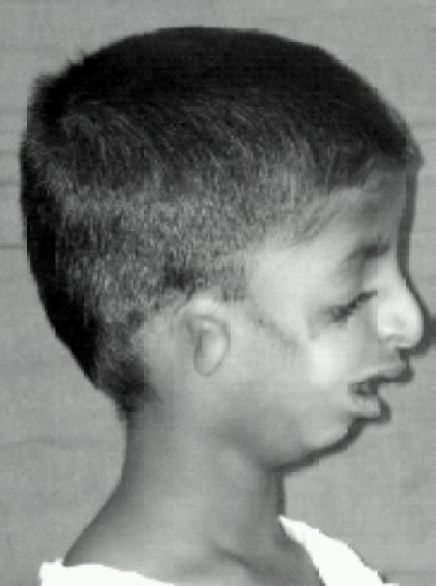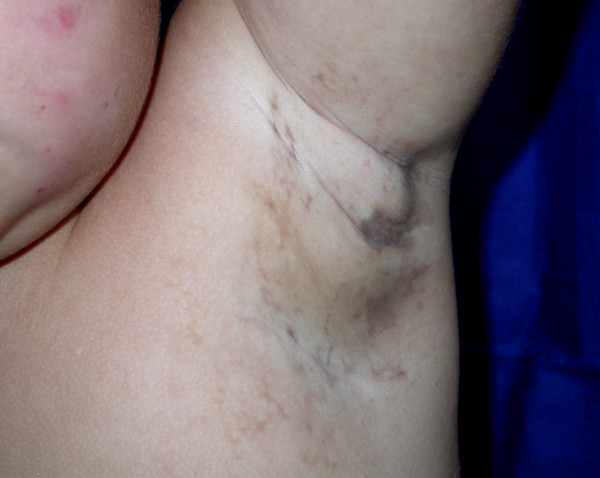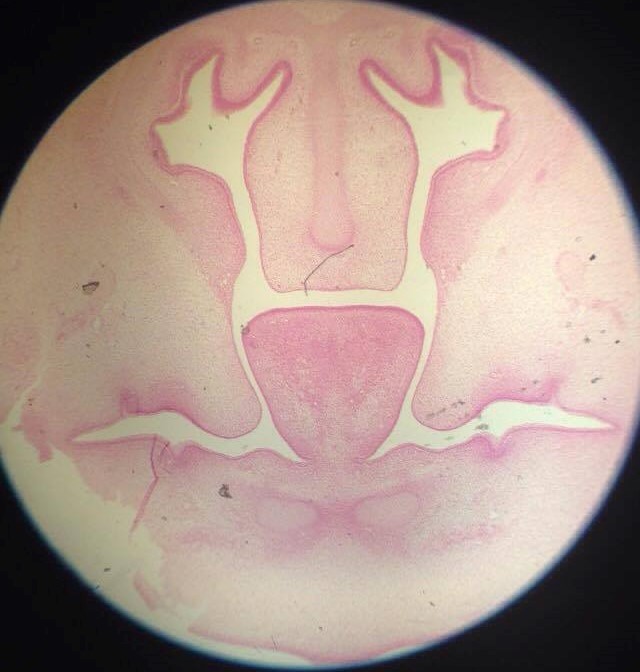|
High-arched Palate
A high-arched palate (also termed high-vaulted palate) is where the palate is unusually high and narrow. It is usually a congenital developmental feature that results from the failure of the palatal shelves to fuse correctly in development, the same phenomenon that leads to cleft palate. It may occur in isolation or in association with a number of conditions. It may also be an acquired condition caused by chronic thumb-sucking. A high-arched palate may result in a narrowed airway and sleep disordered breathing. Examples of conditions which may be associated with a high-arched palate include: * Allergic rhinitis * Apert syndrome * Crouzon syndrome * Down syndrome * Ehlers-Danlos Syndrome * Fragile X syndrome * Incontinentia pigmenti * Marfan syndrome * Treacher Collins syndrome * Upper Airway Resistance Syndrome See also * Minor physical anomalies * Bardet–Biedl syndrome Bardet–Biedl syndrome (BBS) is a ciliopathic human genetic disorder that produces many effects a ... [...More Info...] [...Related Items...] OR: [Wikipedia] [Google] [Baidu] |
Palate
The palate () is the roof of the mouth in humans and other mammals. It separates the oral cavity from the nasal cavity. A similar structure is found in crocodilians, but in most other tetrapods, the oral and nasal cavities are not truly separated. The palate is divided into two parts, the anterior, bony hard palate and the posterior, fleshy soft palate (or velum). Structure Innervation The maxillary nerve branch of the trigeminal nerve supplies sensory innervation to the palate. Development The hard palate forms before birth. Variation If the fusion is incomplete, a cleft palate results. Function When functioning in conjunction with other parts of the mouth, the palate produces certain sounds, particularly velar, palatal, palatalized, postalveolar, alveolopalatal, and uvular consonants. History Etymology The English synonyms palate and palatum, and also the related adjective palatine (as in palatine bone), are all from the Latin ''palatum'' via Old French ''palat ... [...More Info...] [...Related Items...] OR: [Wikipedia] [Google] [Baidu] |
Fragile X Syndrome
Fragile X syndrome (FXS) is a genetic disorder characterized by mild-to-moderate intellectual disability. The average IQ in males with FXS is under 55, while about two thirds of affected females are intellectually disabled. Physical features may include a long and narrow face, large ears, flexible fingers, and large testicles. About a third of those affected have features of autism such as problems with social interactions and delayed speech. Hyperactivity is common, and seizures occur in about 10%. Males are usually more affected than females. This disorder and finding of Fragile X syndrome has an X-linked dominant inheritance. It is typically caused by an expansion of the CGG triplet repeat within the ''FMR1'' (fragile X messenger ribonucleoprotein 1) gene on the X chromosome. This results in silencing ( methylation) of this part of the gene and a deficiency of the resultant protein (FMRP), which is required for the normal development of connections between neurons. Diagno ... [...More Info...] [...Related Items...] OR: [Wikipedia] [Google] [Baidu] |
Palate
The palate () is the roof of the mouth in humans and other mammals. It separates the oral cavity from the nasal cavity. A similar structure is found in crocodilians, but in most other tetrapods, the oral and nasal cavities are not truly separated. The palate is divided into two parts, the anterior, bony hard palate and the posterior, fleshy soft palate (or velum). Structure Innervation The maxillary nerve branch of the trigeminal nerve supplies sensory innervation to the palate. Development The hard palate forms before birth. Variation If the fusion is incomplete, a cleft palate results. Function When functioning in conjunction with other parts of the mouth, the palate produces certain sounds, particularly velar, palatal, palatalized, postalveolar, alveolopalatal, and uvular consonants. History Etymology The English synonyms palate and palatum, and also the related adjective palatine (as in palatine bone), are all from the Latin ''palatum'' via Old French ''palat ... [...More Info...] [...Related Items...] OR: [Wikipedia] [Google] [Baidu] |
Bardet–Biedl Syndrome
Bardet–Biedl syndrome (BBS) is a ciliopathic human genetic disorder that produces many effects and affects many body systems. It is characterized by rod/cone dystrophy, polydactyly, central obesity, hypogonadism, and kidney dysfunction in some cases. Historically, slower mental processing has also been considered a principal symptom but is now not regarded as such. Signs and symptoms Bardet–Biedl syndrome is a pleiotropic disorder with variable expressivity and a wide range of clinical variability observed both within and between families. The most common clinical features are rod–cone dystrophy, with childhood-onset night-blindness followed by increasing visual loss; postaxial polydactyly; truncal obesity that manifests during infancy and remains problematic throughout adulthood; varying degrees of learning disabilities; male hypogenitalism and complex female genitourinary malformations; and renal dysfunction, a major cause of morbidity and mortality. There is a wide ... [...More Info...] [...Related Items...] OR: [Wikipedia] [Google] [Baidu] |
Minor Physical Anomalies
Minor physical anomalies (MPAs) are relatively minor (typically painless and, in themselves, harmless) congenital physical abnormalities consisting of features such as low-set ears, single transverse palmar crease, telecanthus, micrognathism, macrocephaly, hypotonia and furrowed tongue. While MPAs may have a genetic basis, they might also be caused by factors in the fetal environment: anoxia, bleeding, or infection. MPAs have been linked to disorders of pregnancy and are thought by some to be a marker for insults to the fetal neural development towards the end of the first trimester. Thus, in the neurodevelopmental literature, they are seen as indirect indications of interferences with brain development. MPAs have been studied in autism, Down syndrome, and in schizophrenia. A 2008 meta-analysis found that MPAs are significantly increased in the autistic population. A 1998 study found that 60% of its schizophrenic sample and 38% of their siblings had 6 or more MPAs (especially ... [...More Info...] [...Related Items...] OR: [Wikipedia] [Google] [Baidu] |
Treacher Collins Syndrome
Treacher Collins syndrome (TCS) is a genetic disorder characterized by deformities of the ears, eyes, cheekbones, and chin. The degree to which a person is affected, however, may vary from mild to severe. Complications may include breathing problems, problems seeing, cleft palate, and hearing loss. Those affected generally have normal intelligence. TCS is usually autosomal dominant. More than half the time it occurs as a result of a new mutation rather than being inherited from a person's parents. The involved genes may include ''TCOF1'', ''POLR1C'', or ''POLR1D''. Diagnosis is generally suspected based on symptoms and X-rays, and potentially confirmation by genetic testing. Treacher Collins syndrome is not curable. Symptoms may be managed with reconstructive surgery, hearing aids, speech therapy, and other assistive devices. Life expectancy is generally normal. TCS occurs in about one in 50,000 people. The syndrome is named after Edward Treacher Collins, an English surgeon an ... [...More Info...] [...Related Items...] OR: [Wikipedia] [Google] [Baidu] |
Marfan Syndrome
Marfan syndrome (MFS) is a multi-systemic genetic disorder that affects the connective tissue. Those with the condition tend to be tall and thin, with long arms, legs, fingers, and toes. They also typically have exceptionally flexible joints and abnormally curved spines. The most serious complications involve the heart and aorta, with an increased risk of mitral valve prolapse and aortic aneurysm. The lungs, eyes, bones, and the covering of the spinal cord are also commonly affected. The severity of the symptoms is variable. MFS is caused by a mutation in ''FBN1'', one of the genes that makes fibrillin, which results in abnormal connective tissue. It is an autosomal dominant disorder. In about 75% of cases, it is inherited from a parent with the condition, while in about 25% it is a new mutation. Diagnosis is often based on the Ghent criteria. There is no known cure for MFS. Many of those with the disorder have a normal life expectancy with proper treatment. Management of ... [...More Info...] [...Related Items...] OR: [Wikipedia] [Google] [Baidu] |
Incontinentia Pigmenti
Incontinentia pigmenti (IP) is a rare X-linked dominant genetic disorder that affects the skin, hair, teeth, nails and central nervous system. It is named from its appearance under a microscope. The disease is characterized by skin abnormalities that begin in childhood, usually a blistering rash which heals, followed by the development of harder skin growths. The skin may develop grey or brown patches which fade with time. Other symptoms can include hair loss, dental abnormalities, eye abnormalities that can lead to vision loss and lined or pitted fingernails and toenails. Associated problems can include delayed development, intellectual disability, seizures and other neurological problems. Most males with the disease do not survive to childbirth. Incontinentia pigmenti is caused by a mutation in the ''IKBKG'' gene, which encodes the NEMO protein, which serves to protect cells against TNF-alpha-induced apoptosis. A lack of IKBKG therefore makes cells more prone to apoptosis. Th ... [...More Info...] [...Related Items...] OR: [Wikipedia] [Google] [Baidu] |
Palatal Shelves
The development of the secondary palate commences in the sixth week of human embryonic development. It is characterised by the formation of two palatal shelves on the maxillary prominences, the elevation of these shelves to a horizontal position, and then a process of palatal fusion between the horizontal shelves. The shelves will also fuse anteriorly upon the primary palate, with the incisive foramen being the landmark between the primary palate and secondary palate. This forms what is known as the roof of the mouth, or the hard palate. The formation and development of the secondary palate occurs through signalling molecules SHH, BMP-2, FGF-8, among others. Failure of the secondary palate to develop correctly may result in a cleft palate disorder. Formation of palatal shelves The formation of the vertical palatal shelves occurs during week 7 of embryological development, on the maxillary processes of the head of the embryo, lateral to the developing tongue. Palatal shelf ele ... [...More Info...] [...Related Items...] OR: [Wikipedia] [Google] [Baidu] |
Down Syndrome
Down syndrome or Down's syndrome, also known as trisomy 21, is a genetic disorder caused by the presence of all or part of a third copy of chromosome 21. It is usually associated with physical growth delays, mild to moderate intellectual disability, and characteristic facial features. The average IQ of a young adult with Down syndrome is 50, equivalent to the mental ability of an eight- or nine-year-old child, but this can vary widely. The parents of the affected individual are usually genetically normal. The probability increases from less than 0.1% in 20-year-old mothers to 3% in those of age 45. The extra chromosome is believed to occur by chance, with no known behavioral activity or environmental factor that changes the probability. Down syndrome can be identified during pregnancy by prenatal screening followed by diagnostic testing or after birth by direct observation and genetic testing. Since the introduction of screening, Down syndrome pregnancies are often abor ... [...More Info...] [...Related Items...] OR: [Wikipedia] [Google] [Baidu] |




